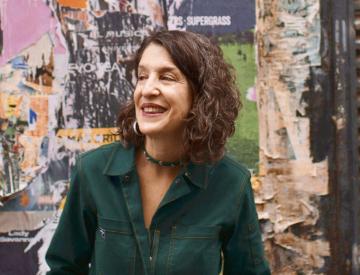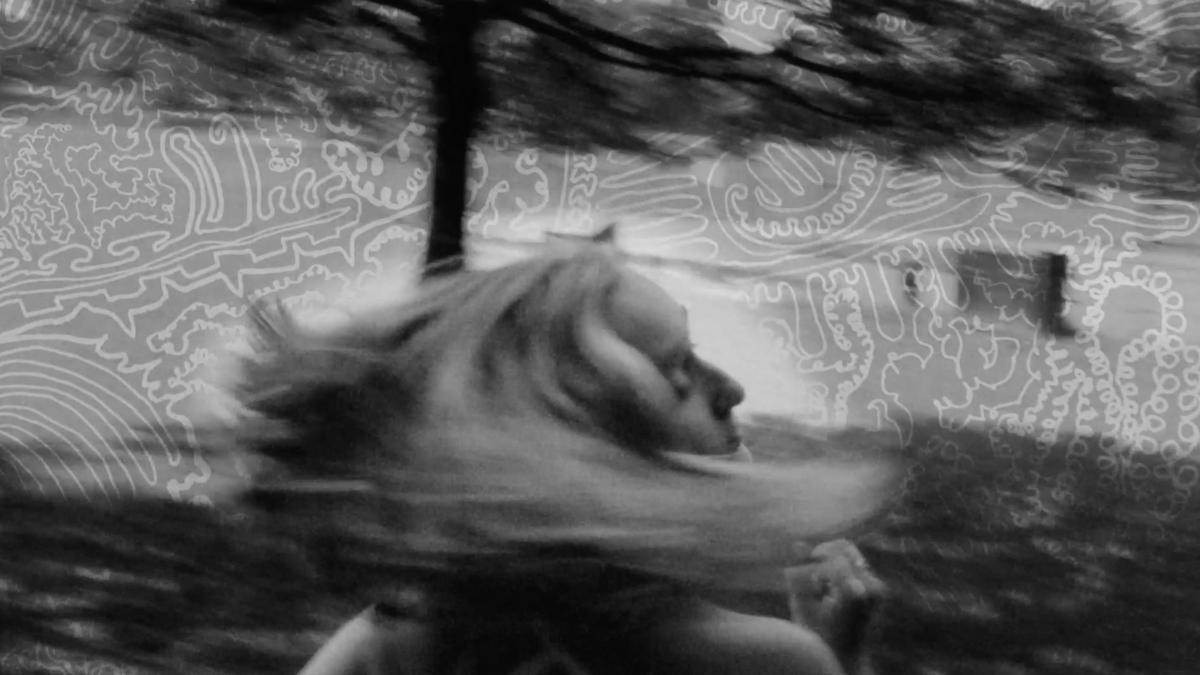Post-screening conversation with Lynne Sachs.
Thursday, February 23 at 6pm | This program of four short and medium-length pieces highlights Sachs’ filmography from a poetic, personal perspective, as she uses her camera to capture the essence of people, places, and moments in time. The scope of this work includes DRIFT AND BOUGH (2014, USA, 6 min., No dialogue / Format: 8mm on digital), an assemblage of 8mm footage from a winter morning in Central Park. Set to sound artist Stephen Vitiello’s delicate and assured score, the contrasting darkness - of skyscrapers, fences, trees, and people - against bright snow, gives way to a meditative living picture. In MAYA AT 24 (2021, USA, 4 min., No dialogue / Format: 16mm on digital), Sachs presents a spinning, swirling cinematic record of her daughter Maya, chronicled at ages 6, 16, and 24. As Maya runs, she glances - furtively, lovingly, distractedly - through the lens and at her mother, conveying a wordless bond between parent and child, and capturing the breathtakingly quick nature of time. Presented for the first time publicly, in VISIT TO BERNADETTE MAYER’S CHILDHOOD HOME (2020, USA, 3 min., In English / Format: 16mm on digital), Sachs visits poet Bernadette Mayer’s childhood home in Queens to celebrate Mayer’s work, through a reverent, flowing collage. Queens, New York is also the backdrop for the poetry of Paolo Javier in SWERVE (2022, USA, 7 min., in various languages with English subtitles / Format: Digital), a “COVID film” that documents people emerging - cautiously, distanced, masked - from the global pandemic, finding their way in the liminal space between “before” and “after,” and connected by language and verse. In collaboration with playwright Lizzie Olesker, THE WASHING SOCIETY (2018, USA, 44 min., In English / Format: Digital) explores the once ubiquitous but now endangered public laundromat. Inspired by “To ’Joy My Freedom: Southern Black Women’s Lives and Labors after the Civil War” by Tera W. Hunter, THE WASHING SOCIETY is an observational study of lather and labor, a document of the lives of working class women who - largely overlooked and underappreciated - load, dry, fold, and repeat. Post-screening conversation with Lynne Sachs.
5 QUESTIONS WITH LYNNE SACHS
(Interview from the January/February issue of the Gazette)
Your films are often so collaborative in nature - inspired by or featuring poets, authors, fellow artists, musicians. How do you forge these partnerships?
From the very beginning of my life as a filmmaker, I resisted the traditional, pyramid structure for the industry. If film is an art, why does it have to embrace this kind of corporate model? I never wanted to direct movies. I wanted to make films. Rigid hierarchies just seem anachronistic and patriarchal to me. When I work with other people on my films, I look for kindred spirits with a shared passion and enthusiasm. In 1991, I shot film of a dear friend rolling nude down a sand dune in Death Valley. She only agreed to take off her clothes if I would stand nude while doing the filming. I had to agree, of course. That was a collaboration for THE HOUSE OF SCIENCE. In 1994, I traveled with my Bolex, a cassette recorder and a notebook through Vietnam with my sister to make WHICH WAY IS EAST, an essay film constructed around our sometimes parallel, sometimes divergent perspectives. That was another collaboration. In 2006, I asked a former student to exchange letters with me as we both contemplated the fraught situation in Israel/ Palestine. Our epistolary exchange became the foundation for a collaborative writing endeavor. In 2018, artist Barbara Hammer asked me to work with film material that she had shot twenty years before. She knew she was dying and that our friendship could transform her images into a collaborative experience. I completed this cross-generational collaboration and called it A MONTH OF SINGLE FRAMES. Perhaps my most sustained collaboration has been with sound artist Stephen Vitiello. His deeply inventive approach to making music continuously reminds me of how lucky I am to live in a world with other creative people who find sustenance from the shared joy of making work. When I look at DRIFT AND BOUGH, YOUR DAY IS MY NIGHT, THE WASHING SOCIETY, TIP OF MY TONGUE, and FILM ABOUT A FATHER WHO, I am reminded of our connections, what we did together and what I learned from this vital human being.
Who are your cinematic heroes?
Sometimes a person is lucky enough to experience a hero and a mentor all wrapped into one. That is what happened to me. The first time I witnessed (as opposed to just saw) Bruce Conner’s iconoclastic and irreverent collage films in 1984 (A MOVIE, VALSE TRISTE, and CROSSROADS), I was transfixed. Never before had I imagined that a short, experimental film could be so radical, so rhythmic and so inexplicably resonant. I wrote to him a year later expressing an interest in working with him as an assistant in his studio in San Francisco. To my surprise, he said yes. Though I had little to offer except for curiosity and enthusiasm, I spent a year at his side, helping him organize his archive, parsing through letters he’d received from fans and driving him around in his convertible looking for Geiger counters with which to assess the radioactivity in his neighborhood. Not long after I completed my work with Bruce, I began a two year assistant position with Trịnh T. Minh Hà. Her presence in my life pushed me in completely different ways. As a filmmaker, poet, and cultural theorist, Minh-ha showed me how artists with cameras could analyze the way that they look at the world. She really introduced me to the idea of self-reflexivity in cinema. An artist’s embrace of words and images should bring together observation and introspection through a constant lens of doubt. I recorded sound on her films (SURNAME VIET GIVEN NAME NAM and SHOOT FOR THE CONTENTS) and assisted in her editing room. Other filmmaker heroes whose set my mind a-spinning, include: Peggy Ahwesh, Zeinabu Irene Davis, Maya Deren, Jeanne Finley, Christopher Harris, Su Friedrich, Zora Neal Hurston, Lucretia Martel, Yvonne Rainer, Julia Reichardt, Mark Street, Reverend L.O. Taylor, Kidlat Tahimik, and so many more.
What advice would you give to students studying film/filmmaking?
Early in my career as a filmmaker, I gave up a volunteer job working for a the brilliant, progressive documentary filmmaker Barbara Kopple to take a paid job with a commercial company making Marine Corp promotional videos. It was horrible, and I cried every afternoon sitting at the telephone answering calls. I was an unglorified secretary. In retrospect, I wish I had continued waitressing (even after I spilled an entire tray on a woman’s lap) to pay the bills so that I could keep my production assistant position on Kopple’s AMERICAN DREAM, where I would have learned more and been more inspired. Continue to make short films throughout your life as an artist. Making features can be a deeply meaningful and totally immersive experience, but the joy of coming up with an idea and then seeing it to completion over a few months or a year is equally profound. It’s like deciding between writing a poem or a novel. Both are worthy, but one is certainly more likely to be cheaper and more liberating to produce. Plus interest in short films is soaring these days! Being part of an artist community is as gratifying as establishing yourself as a successful filmmaker. Create a collective for exhibiting your work as well as those of other artist friends by curating programs in alternative spaces like garages, attics, backyards and basements. Support each other by telling your friends about grant opportunities, bringing cupcakes to their set, or teaching them how to use a Bolex 16mm camera. Show compassion to other artists by engaging with them around their struggles and their joys.
What is a memorable moviegoing experience you’ve had?
I had always wanted to see Czech New-Wave filmmaker Věra Chytilová’s 1966 feature film DAISIES, a renowned, anti-authoritarian send-up of insatiable desires and female friendship. My own friend Kathy Geritz, now a curator at the Pacific Film Archive in Berkeley, and I got hold of a 16mm print and invited anyone who was interested to join us in a small theater. For weeks, we were giddy with anticipation. The day arrived and both of us set ourselves up in the projection booth, happy to be responsible for what we saw as a historical event, at least in our lives. Together, we swooned with excitement in the booth, completely taken with Chytilová’s brilliant direction. From behind the glass between the booth and the theater, we caught site of two arms flailing in the air. Only once the credits started to roll, and the audience began to exit the theater did we discover that a man in the room had had a disturbing and mysterious episode that involved loud grunting and running around the room during the film. I never figured out if he hated the film or was, himself, so deeply moved by the exhilarating performance of its two female stars that he too chose to let it all hang out.
What film do you watch again and again?
I have watched SANS SOLEIL by Chris Marker at least 20 times. I discover something about the punctum in an image – the accident that pricks, as Roland Barthes might call it - in his discursive, layered, evocative, astute essay film every time I watch it.
Lynne Sachs: A Poet's Perspective
Committed to a dialogue between cinematic theory and practice, experimental filmmaker and poet Lynne Sachs searches for a rigorous play between image and sound, pushing the visual and aural textures in each new project. Embracing archives, letters, portraits, confessions, poetry, and music, her films take us on a critical journey through reality and memory. Regardless of the passage of time, these films continue to be extremely contemporary, coherent, and radical in their artistic conception.
 Lynne has produced over 40 films as well as numerous live performances, installations, and web projects. Over the course of her career, Lynne has worked closely with fellow filmmakers Craig Baldwin, Bruce Conner, Barbara Hammer, Chris Marker, Gunvor Nelson, Carolee Schneemann, and Trinh T. Minh-ha. Sachs’ films have screened at MoMA, Tate Modern, Image Forum Tokyo, Wexner Center for the Arts, the New York Film Festival, Oberhausen Int’l Short FF, Punto de Vista, Sundance, Vancouver IFF, Viennale, and Doclisboa, among others. In 2021, Sachs received awards from both Edison Film Festival and Prismatic Ground Film Festival at the Maysles Documentary Center for her achievements in the experimental and documentary fields.
Lynne has produced over 40 films as well as numerous live performances, installations, and web projects. Over the course of her career, Lynne has worked closely with fellow filmmakers Craig Baldwin, Bruce Conner, Barbara Hammer, Chris Marker, Gunvor Nelson, Carolee Schneemann, and Trinh T. Minh-ha. Sachs’ films have screened at MoMA, Tate Modern, Image Forum Tokyo, Wexner Center for the Arts, the New York Film Festival, Oberhausen Int’l Short FF, Punto de Vista, Sundance, Vancouver IFF, Viennale, and Doclisboa, among others. In 2021, Sachs received awards from both Edison Film Festival and Prismatic Ground Film Festival at the Maysles Documentary Center for her achievements in the experimental and documentary fields.
The Film Center, in collaboration with Conversations at the Edge and the School of the Art Institute of Chicago’s Film, Video, New Media, and Animation program, is honored to welcome Sachs to the Film Center in person for two evenings of her work, followed by in-depth conversations. Photo credit: Inés Espinosa López.
Related Event: FILM ABOUT A FATHER WHO with Lynne Sachs
Please check our full COVID-19 policy and details below:


